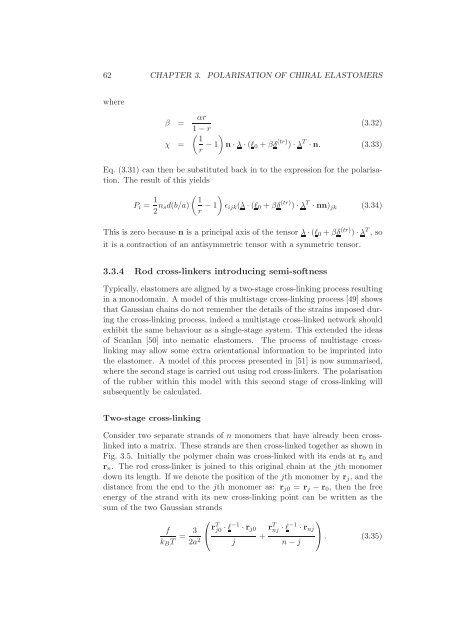Statistical models of elasticity in main chain and smectic liquid ...
Statistical models of elasticity in main chain and smectic liquid ...
Statistical models of elasticity in main chain and smectic liquid ...
Create successful ePaper yourself
Turn your PDF publications into a flip-book with our unique Google optimized e-Paper software.
62 CHAPTER 3. POLARISATION OF CHIRAL ELASTOMERSwhereβ =χ =αr(3.32)(1−r) 1r −1 n·λ·(l 0 +βδ (tr) )·λ T ·n. (3.33)Eq. (3.31) can then be substituted back <strong>in</strong> to the expression for the polarisation.The result <strong>of</strong> this yieldsP i = 1 ( ) 12 n sd(b/a)r −1 ǫ ijk (λ·(l 0 +βδ (tr) )·λ T ·nn) jk (3.34)This is zero because n is a pr<strong>in</strong>cipal axis <strong>of</strong> the tensor λ·(l 0 +βδ (tr) )·λ T , soit is a contraction <strong>of</strong> an antisymmetric tensor with a symmetric tensor.3.3.4 Rod cross-l<strong>in</strong>kers <strong>in</strong>troduc<strong>in</strong>g semi-s<strong>of</strong>tnessTypically, elastomers are aligned by a two-stage cross-l<strong>in</strong>k<strong>in</strong>g process result<strong>in</strong>g<strong>in</strong> a monodoma<strong>in</strong>. A model <strong>of</strong> this multistage cross-l<strong>in</strong>k<strong>in</strong>g process [49] showsthat Gaussian cha<strong>in</strong>s do not remember the details <strong>of</strong> the stra<strong>in</strong>s imposed dur<strong>in</strong>gthe cross-l<strong>in</strong>k<strong>in</strong>g process, <strong>in</strong>deed a multistage cross-l<strong>in</strong>ked network shouldexhibit the same behaviour as a s<strong>in</strong>gle-stage system. This extended the ideas<strong>of</strong> Scanlan [50] <strong>in</strong>to nematic elastomers. The process <strong>of</strong> multistage crossl<strong>in</strong>k<strong>in</strong>gmay allow some extra orientational <strong>in</strong>formation to be impr<strong>in</strong>ted <strong>in</strong>tothe elastomer. A model <strong>of</strong> this process presented <strong>in</strong> [51] is now summarised,where the second stage is carried out us<strong>in</strong>g rod cross-l<strong>in</strong>kers. The polarisation<strong>of</strong> the rubber with<strong>in</strong> this model with this second stage <strong>of</strong> cross-l<strong>in</strong>k<strong>in</strong>g willsubsequently be calculated.Two-stage cross-l<strong>in</strong>k<strong>in</strong>gConsider two separate str<strong>and</strong>s <strong>of</strong> n monomers that have already been crossl<strong>in</strong>ked<strong>in</strong>to a matrix. These str<strong>and</strong>s are then cross-l<strong>in</strong>ked together as shown <strong>in</strong>Fig. 3.5. Initially the polymer cha<strong>in</strong> was cross-l<strong>in</strong>ked with its ends at r 0 <strong>and</strong>r n . The rod cross-l<strong>in</strong>ker is jo<strong>in</strong>ed to this orig<strong>in</strong>al cha<strong>in</strong> at the jth monomerdown its length. If we denote the position <strong>of</strong> the jth monomer by r j , <strong>and</strong> thedistance from the end to the jth monomer as: r j0 = r j − r 0 , then the freeenergy <strong>of</strong> the str<strong>and</strong> with its new cross-l<strong>in</strong>k<strong>in</strong>g po<strong>in</strong>t can be written as thesum <strong>of</strong> the two Gaussian str<strong>and</strong>s⎛⎞fk B T = 3 ⎝ rT j0 ·l−1 ·r j0 r T nj ·l−1 ·r nj2a 2 + ⎠. (3.35)j n−j
















